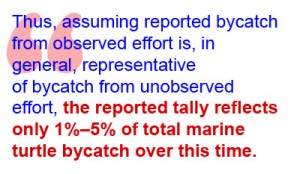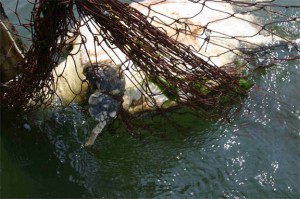![]()
It’s an article packed full of potential contention as it speaks to a variety of issues involving fisheries management. So thank God we are dealing with a charismatic marine species or we just may be contemplating their extinction. But then again, perhaps we are doing just that since all 7 species of marine turtles are listed under the Endangered Species Act. So what does that mean when millions of sea turtles are caught as bycatch in just 18 years? I think it means the status quo is definitely due for an overhaul to say the least.
 Bycatch. It’s a word that sounds rather innocuous as it rolls off the tongue, but clearly does not do justice to the staggering amount of life that is instantly converted to simple biological waste. It’s a problem that amounts to tonnes, in the neighborhood of several million per year. And again I say thank God because the widely popular sea turtle may be able to help shine the light on an ever growing problem responsible for population declines in multiple species. Well, at least I hope so.
Bycatch. It’s a word that sounds rather innocuous as it rolls off the tongue, but clearly does not do justice to the staggering amount of life that is instantly converted to simple biological waste. It’s a problem that amounts to tonnes, in the neighborhood of several million per year. And again I say thank God because the widely popular sea turtle may be able to help shine the light on an ever growing problem responsible for population declines in multiple species. Well, at least I hope so.
In Global Patterns of Marine Turtle Bycatch, gillnets, longlines, and trawl fisheries are providing us with a perspective that we would probably rather ignore. Unfortunately the out of sight out of mind attitude is not helping the sea turtle situation and it reminds me of an old mantra I used, “The catch of the day may cost more than you think.” In this scenario, that cost is…
The total reported global marine turtle bycatch (1990-2008) was ∼85,000 turtles, but due to the small percentage of fishing effort observed and reported (typically <1% of total fleets), and to a global lack of bycatch information from small-scale fisheries, this likely underestimates the true total by at least two orders of magnitude.
 And after looking at the data I am left wondering how many sea turtles are actually killed or die as a result of wounds incurred by coming into contact with gillnets, longlines and trawls. I can imagine it is only palatable when wearing a pair of rose colored glasses. But as far as the research goes, there was insufficient data to incorporate mortality rates.
And after looking at the data I am left wondering how many sea turtles are actually killed or die as a result of wounds incurred by coming into contact with gillnets, longlines and trawls. I can imagine it is only palatable when wearing a pair of rose colored glasses. But as far as the research goes, there was insufficient data to incorporate mortality rates.
The study found the bycatch per unit effort (BPUE) varied greatly depending upon the region and fishing method employed. In fact , it identified certain hotspots that are a cause for concern and highlight the need for fisheries management intervention.
Based on reported sea turtle bycatch, the maximum BPUEs found for each fishing method are as follows:
- 2.2 turtles per set for gillnets in the Mediterranean Sea
- 19.3 turtles per 1,000 hooks for longlines in the eastern Pacific Ocean
- 7.2 turtles per haul for trawls in the southwest Atlantic Ocean
“Targeted action to reduce turtle-gear interactions is essential for population persistence, and is already underway for some fleets…our study revealed that reports of longline bycatch are two-fold more common than reports of bycatch in either trawls or gillnets.”
Having the data means we have no more excuses for not developing, continuing to develop and implementing a conservation plan that is both regional and fishing gear specific. The plan must be more than focusing on turtle excluder devices, but must include other innovative management techniques on the lines of time-area closures, etc. And since time is of the essence and marine turtle populations are at risk, immediate action is required.
![]()
Wallace, B., Lewison, R., McDonald, S., McDonald, R., Kot, C., Kelez, S., Bjorkland, R., Finkbeiner, E., Helmbrecht, S., & Crowder, L. (2010). Global patterns of marine turtle bycatch Conservation Letters DOI: 10.1111/j.1755-263X.2010.00105.x


It’s a sad story, and the unfortunate side effect of it is the under-reporting of by-catch. The sad part is much of these things go unreported out of fear. Fishermen work hard to try to make a decent living, and they fear regulations that will shut them down. This creates then a major problem for fisheries managers, because they aren’t getting accurate data, and especially not accurate data on non-target bycatch species. Why report a turtle caught in a trawl if the regulation is 1 turtle caught shuts down vessel operations for a certain length of time? It is quite a problem that needs to be addressed, but who knows the best way to approach it?
Well said John. Unfortunately a proper approach for reform is not quite clear. But operating under the status quo means that industry/fishermen are potentially ignoring the even greater problem when we ultimately discover one day that a species has been fully overfished…and harvesting is put on hold indefinitely. The ecosystem has a lot to lose in this situation as well as livelihoods of many. And that should be a driving factor for instituting sustainable practices and in essence should spark self regulation for the fear of maintaining jobs in the long-term. But yet again we find ourselves dominated by a culture focused on short-term and immediate gains.
Thanks for making us think a little more about it.
Great post. I agree with John – the industry is means for many, and reporting needs to be better, but how to make it so is the challenge. And there’s no doubt that the sea turtle is a huge draw – and it’s hugely popular among KIDS, which is a great thing for its potential longevity (once we get to the point where we can even say “longevity”).
.-= Cindy BeMent´s last blog ..Pick/Protect 21: Atlantic Bluefin Tuna =-.
Thanks Cindy! It might just sound like political pandering, but comprehensive reform is what is needed as well consumer responsibility. It is so easy to ignore or overlook a situation as most of us have no idea what it took (in terms of bycatch) to get that tuna steak on our plate. We see the end result as opposed to understanding the big picture. Consumers control the marketplace and we have to speak up with our wallets and demand sustainably caught foods.
[…] Turtle-exclusion-devices are one of the success stories of marine conservation. But that doesn’t mean huge numbers of turtles aren’t being accidentally killed by other fishing practices. […]
Unfortunately it is going to take a lot of work to counter the effect that humans have on the sea turtle population. If anyone in interested in having a POSITIVE impact on sea turtles, Friends of the Osa runs a volunteer sea turtle conservation program on the beaches of the Osa Peninsula, Costa Rica. We need all the help we can get for the upcoming nesting season (June – December)! See our website for details: http://www.osaconservation.org/Volunteer.html
Thanks!
Thanks Shawn and you are in deed correct that it will not be an overnight process to rectify a situation that has been allowed to continue for so long. That’s exactly why it is important for everyone to get involved…no matter if the effort is large or small. And your conservation program is a great opportunity for making a much needed difference.